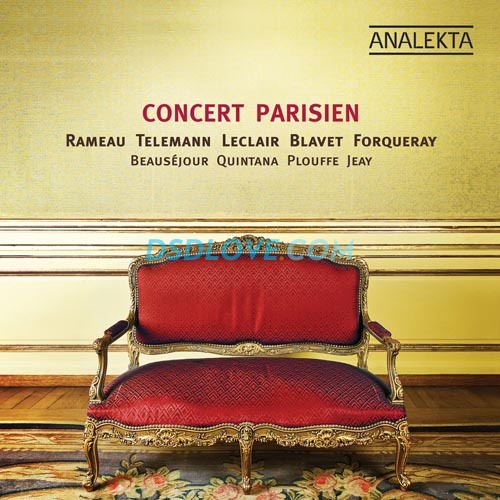|
|
本区为您推荐超多资源,以及Hi-res资源,欢迎大家一起努力为论坛添砖加瓦!
封面:
wfrcdsfa4dv.jpg

简介:
As in the time of Louis XV, four musicians gather to play music among friends. Luc Beauséjour, Hélène Plouffe and Grégoire Jeay join Argentinean Juan Manuel Quintana in a feast of pieces centered around the 1740s Paris. Works by Telemann, Blavet, Forqueray and Leclair featuring the violin, the flute and the viola da gamba intertwined with excerpts from Rameau’s Clavecin en concert.For Voltaire, 1775, the year of the death of Louis XIV “would mark the end of a great era, after which everything would seem drab and paltry.” Actually, until mid-century, French and world history lacked major events. In fact, after the stabilization of social, economic and intellectual structures in the eighteenth century, the deeper strata of society began to shift. These subterranean upheavals, hardly discernible to contemporary Frenchmen, were to pave the way for the “Lumières” (the Age of Enlightenment) and the fall of the regime.While great and small courts from Spain to Russia and from Stockholm to Naples were building imitations of Versailles and adopting the language and style of the Sun King, intellectuals and avant-garde artists were thronging to Paris, which had become the model of good taste in Europe and, more than ever, the fount of culture. Wealth was no longer the sole privilege of the nobility. The successful bourgeoisie, especially that of high finance, cultivated patronage, as was the case of the farmers-general, who were great music lovers. Literary salons, temples of wit, followed suit and became more open to musical fashions.Of course, the musical mecca was still the Royal Academy, with its surviving high privileges instituted by Lully, and the Opera. Since 1725, the Concert Spirituel had been offering twenty to twenty-five events a year to a paying audience. During the same period other musical societies, where one could find foreign composers, first Italian and gradually, German, came into being. At the financier Crozat’s domain, concerts were held twice weekly. Madame de Prie’s “Concert Italien,” also scheduled twice a week at the Tuileries, next to the Concert Spirituel, relied on sixty subscribers thanks to whose generosity the best artists were hired. The Prince of Conti, the Duke of Aumont, and later the Baron Bagge, to name but the more fortunate nobles, music lovers and often competent performers and composers themselves, also offered music. But so did musicians, who, in order to attract an audience, try out new programs and treat their friends, organized private concerts.曲目:
Rameau, Jean Philippe (1683-1764) :
Troisième Concert, Excerpt From Clavecin En Concert 14:24
01. I. La Lapoplinière 4:06
02. II. La Timide 7:45
03. III. Tambourin I & II 2:33
Telemann, Georg Philipp (1681-1767) :
Quartet In G Major 10:57
04. I. Grave, Allegro, Grave, Allegro 2:54
05. II. Largo 0:39
06. III. Presto 2:33
07. IV. Largo 0:43
08. V. Allegro 4:08
Blavet, Michel (1700-68) :
Sonata No. 3 In E Minor, Op. 3 7:59
09. I. Vivace 2:44
10. II. Largo poco andante 2:55
11. III. Allegro 2:20
Forqueray, Antoine (1671-1745) :
12.La Buisson 5:25
Rameau, Jean Philippe (1683-1764) :
13.Pièces de Clavecin en concert, Cinquième concert: I. La Forqueray 3:45
Pièces de Clavecin en concert, Cinquième concert, RCT 11 8:25
14. II. La Cupis 5:49
15. III. La Marais 2:36
Leclair, Jean-Marie (1697-1764) :
Trio Sonata In D Major 11:19
16. I. Adagio 2:34
17. II. Allegro 2:10
18. III. Sarabande - Largo 4:01
19. IV. Allegro 2:34
|
|